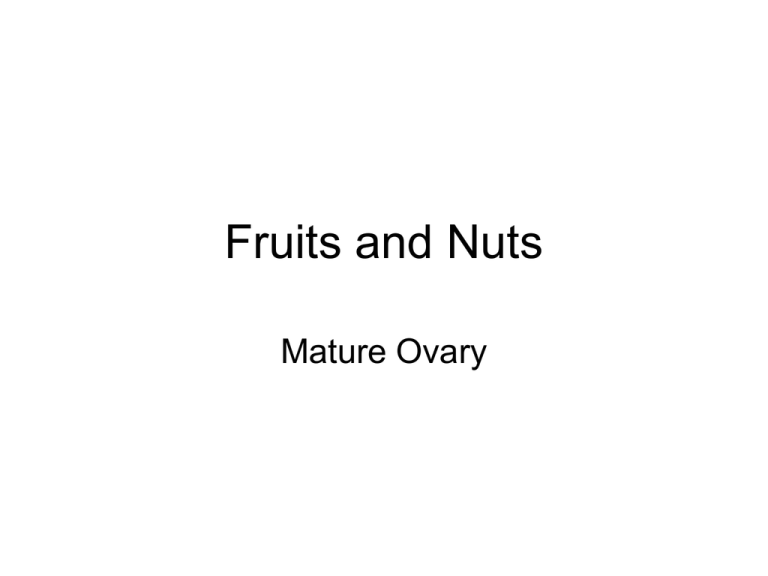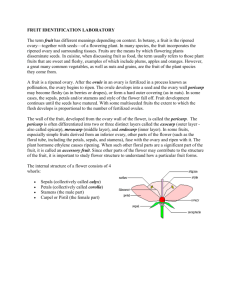Fruits and Nuts
advertisement

Fruits and Nuts Mature Ovary Biology • What is the difference between fruit and vegetable????? • Mature ripened ovary along with its contents and any adhering accessory structure to protect the seed and includes seeds • Agamospermy - Unfertilized fruit and therefore solely made up of maternal tissue • Parthenocarpy – maturation of fruit with out seed formation. Any Example??? Fruit • Important for food dispersal • Many fruits are fleshy and contain sugars that attract animals – Pass through digestive system successfully – disperse the tender seeds far away from parent plant • Non-fleshy fruits use other mechanism for dispersal Fruit • Ovary wall thickens and forms pericarp with three layers – Exocarp – outer most layer usually made up of epidermis – Mesocarp - middle layer; varies in thickness – Endocarp – inner most; shows considerable variations • Fruit types: – Simple (one ovary one flower), aggregate (many ovaries one flower), multiple (many ovaries many flowers) and accessory (Other tissues surrounding the ovary; usually flowers with inferior ovary) Classification of fruits • Handout Fruit Chemistry • One of the important constituents of our diet and provides 1/3 of required calories, vitamins and minerals • Has high amount of water (60-90%) and very little fat or proteins. • CHO are mainly free sugars (glucose and fructose) form main nutrient component • Some are particularly rich in vitamins and minerals • Many contain tannins and pectins A Nut • Entire fruit with hard shell • A seed developed in a stony endocarp • High in nutrients – Fat – edible oil – Proteins – High in mineral content – Low in carbohydrates Temperate and Tropical fruits • • • • Tropical fruits – form staple diet Temperate fruits – additive fruits Sweet varieties consumed raw Acidic one preserved as jams, jellies, juices and syrups Apples and their relatives • Rosaceae with four subfamilies – Spiraeoideae – spirea – Maloideae – apples; pome type of fruit – Amygdaloideae – plums, drupes type of fruit – Rosoideae – rose, aggregate type of fruit Apples and their relatives Apples(pome) • Malus Xdomesticus or M. asiaticus – Old world from Eurasia – Johnny Appleseed?? & Adam and Eve (apple or apricot) – Diploid or triploid (n=17) – Mainly grown by grafting • Pome, fleshy receptacle; inferior ovary; 918% sugars,1% acid, 0.5% tannins and proteins, vit. C; K; Ca; P and pectin Apples and their relatives Pears (pome) • Pyrus communis; P. pyrifolia (Asian pear) – Second largest temperate fruit crop – Originated in Asia – Fleshy receptacle; inferior ovary; pome – Grittyness due to stone cells (cells with very thick wall) – Fructose; pectin, thiamine and phosphatides; peel has vit. C an biotin Apples and their relatives Quinces (pome) • Cydonia oblonga – Hard aromatic flesh – More stone cells than pear – Used as a rootstock for pears – Mainly made into preserves and conserves Plums and other stones • Amygdaloideae – – – – Plums (Prunus domestica) Cherries (P. avium; sweet and P.cerasus; sour ) Peaches (P. persica) Apricots (P.armeniaca) • A drupe; skin is exocarp; fleshy edible part is mesocarp and stony endoccarp with seed inside. • Native of central or western China • Some are New world – plums and cherries False berries • Rosoideae – Strawberries (Fragaria Xananassa); vit c, 1.5% organic acid; anthocyanins – Raspberries (Rubus idaeus) tocopherols – Blackberries (R. occidentalis) anthocyanins • Aggregate fruit • Strawberry -Central fleshy receptacle with individual fruits developing from free ovaries; individual fruit is achene • Raspberries and blackberries – receptacle not swollen; each fruit is a fleshy drupe Blueberries and cranberries • Ericaceae or Heath family: – Blue berries(Vaccinum corymbosum and V. angustifolium) – Cranberries (V. macrocarpum and V.oxycoccos) • Fleshy indehiscent fruit; Drupe; vit A, C, mallic acid; tannins and anthocyanins Grapes • Vitis vinifera – Vitaceae • A woody perennial from middle Asia 8000BC. • Moved westward to Italy, Germany, France and Spain. • 175 table varieties • V. labrusca, the fox grape – concord, catawba grapes • Raisins are dried grapes Kiwi • Actinidia deliciosa – Actinidiaceae native of Asia, called as Chinese gooseberry. • Introduced into New Zealand • Agressively marketed, changed the name • Dioceous plant therefore Temperate Nuts • Nuts are kind of dry fruit with single seed, hard pericarp, and a husklike involucre partially enclosing the fruit • Chestnut; hazelnut; pecans; and walnut. • Peanut, Almond?? • Most have wind pollinated flowers Pecans and Walnuts • Juglandaceae: – Persian walnut – J. regia; Southeastern Europe and Asia – Black walnut – J.nigra; N. America • Allelopatic – Pecans, Hicokery and butternut – Carya • Rosaceae – Almonds –Prunus dulcis – Pistachio – Pistaceae vera Tropical • Rutaceae – Citrus • Cucurbitaceae – Squash • Solanceae – Tomato – Eggplant – Pepper • Palms – Coconut – Dates Citrus • Trees with evergreen leaves, cultivated plants originated in SE Asia. • Some researchers feel that all cultivated citrus came from 3 original species. • Citrus easily to produce hybrids so this adds to the confusion. • Fruit is an hesperidium which is a berry – Exocarp and mesocarp - a tough skin. The skin has cavities filled with aromatic oils. – Endocarp - edible part with hairs modified into juice sacs. • cannot tolerate freezing temperatures, require soil moisture, sun and dry air. • Bud grafting is most common method of propagation. Citrus • Sweet orange - Citrus sinensis - most widely grown, possibly of hybrid origin. • Lemon - Citrus lemon - used for flavoring, deodorants • Bitter orange - C. aurantium - preserves, marmalade, liquers • Lime - C. aurantriifolia - juice used to prevent scurvy, Limeys • Grapefruits - C. paradisi - possibly a cross between pumello (C. maxima) and C. sinensis, probably in W. Indies. Pink grapefruits arose as a bud mutation. • Tangerine - C. reticulata - probably a biological species and not a hybrid. Squashes • Cucurbitaceae • Fruit is a pepo which is an accessory fruit produced from an inferior ovary, the skin or rind is composed of ovary wall and perianth. • Edible squash dates from 6000 ybp in Peru but it was probably used earlier since edible members of this family would have been collected by huntergatherers. • Most squashes are annuals, vines and dioecious, • Cucurbita, taxonomy is very confused – Cucurbita pepo - pumpkins, zucchini, summer squashes • Citrullus lanatus- watermelon, from Africa • Cucumis melo - cantaloupe, musk and honeydew melons, probably from Africa • Cucumis sativus - cucumber, from S. Asia Tomatoes and Peppers • Solanaceae • Fruit is a berry. • Tomato - Lycopersicon esculentum – scientific name means juicy wolf peach. – native to E. Mexico, tomatoes were thought to be an aphrodisiac by French, – used to evoke wolves by Germans, Rumors of toxic nature of tomatoes persisted until 1820. Tomatoes were not important until processing industry developed to produce canned and bottled products - juice, whole tomatoes, paste, catsup. – Plants are outbreeding perennials, selection has been for selfpollination. – Cherry tomatoes are closer to wild types than large-fruited cultivars. • Sweet peppers - Capsicum annuum - from Mexico, 8000 ybp. Palms • Coconut: Cocos nucifera - monocot, very imporant plant in tropics, used for oil, fiber, food and drink. – Origin is controversial since coconuts can be dispersed by ocean currents. – Coconuts are monecious, mature fruit contains one seed which is the largest one known. – Green coconuts have liquid endosperm which solidifies to form the "meat". The coconut "apple" is the base of the developing embryo and can also be eaten. • Date palm - Phoenix dactylifera – found in arid regions around Meditteranean, domesticated for 6500 years. – Dates contain large amounts of carbohydrates, "Tree of life" to Bedouins. Tropical • • • • • • • Pineapple Banana Figs Avacados Mangoes Pomegranates Papaya Tropical Fruits • • • Pineapple - Ananas comosus – a multiple fruit formed by 100-200 fused ovaries. – Fruits develop without pollination - parthenocarpic Hawaii is currently world's largest producer of pineapples due to efforts of J. P. Dole. – pineapple contains a proteolytic enzyme and therefore don't put fresh or frozen pineapple in jello, gelatin is an animal protein and it will not set Bananas - Musa paradisica– Fruit is a berry – origin is obscured by hybridization and polyploids, selection for seedlessness. – Adult plants are giant herbs. Flowers are monoecious, fruit is an accessory type formed from an inferior ovary. Main obstacle to commercial development of bananas was control of spoilage, which was done around 1930. Breadfruit and Jackfruit - Artocarpus – Native to Polynesia, tree that produces multiple fruits. – The mutiny on the H.M.S. Bounty occurred during an excursion to collect breadfruits. Tropical Fruits • Avocados - Persea americana – Have high oil content, known only as a cultivated species from at least 9000 ybp in New World. – Was made popular by denying it was an aphrodisiac in 1920's. • Mangoes - Mangifera indica – From SE Asia, important food source for poor of Jamaica and Haiti and can also be found in U.S. supermarkets. • Pomegranates - Punica granatum – source of word for grenade since fruits will shatter and scatter seeds when thrown down. Tropical nuts • Cashews – Anacardium occidentale. – The "nuts" are seeds, member of same family as poison ivy. – Latex in seed coat is irritating. • Macadamia – Macadamia integrifolia sweet, buttery expensive nut grown mainly in Hawaii









